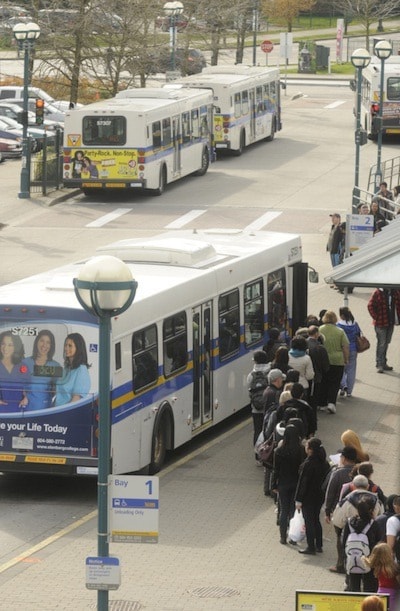The Surrey area has been the big beneficiary of TransLink's strategy of shuffling bus service to carry more people with the transportation authority's limited resources.
Richmond and Maple Ridge, on the other hand, saw a net decrease in bus service between 2010 and 2013, according to a new TransLink report on bus system performance.
It suggests TransLink is reaping gains from its ongoing service optimization initiative, which culls service hours from some routes or times where buses are underused and bolsters service in areas where overcrowded buses routinely pass up waiting passengers, or where more buses could attract new riders.
Over the three-year period, the South of Fraser bus routes were allocated 11 per cent more service hours, while the North Shore got an extra 8.9 per cent.
Richmond, however, was reduced by 3.9 per cent and Maple Ridge/Pitt Meadows bus service was cut 2.3 per cent. Changes were minimal elsewhere in the region.
Bus ridership increased in all parts of the region except Burnaby between 2010 and 2013, with gains of two per cent in Vancouver, the North Shore and the Tri-Cities, 10 per cent in Richmond, 11 per cent in Maple Ridge/Pitt Meadows, 15 per cent South of the Fraser (Surrey, White Rock, Langley, North Delta) and a 21 per cent increase in South Delta.
Overall, it means TransLink is moving about three per cent more people by bus with largely the same resources as 2010 – an extra eight million trips per year.
"We're pleased with the results," said Jeff Busby, TransLink's senior manager of project development. "We're trying to do the best we can with the resources we have."
Busby said the cut in Richmond bus service was because many residents began using the Canada Line after it opened in 2010.
The report says the strategy has eased crowding on routes like the 25, 41, and 99 B-Line in Vancouver, the 319 in Surrey, 106 in Burnaby/New West and the 410 in Richmond.
It also allowed the launch of new routes such as the 188 along Coast Meridian and David Avenue in the Tri-Cities and extending the 335 in Surrey to Newton along 72 Avenue.
Some new money was invested in Surrey and Langley, beyond reallocated hours taken from other parts of the region, to launch the new 555 express bus from Langley over the Port Mann Bridge and the new King George B-Line.
Busby said some gains have come from making bus schedules more efficent, with better route designs that reduce the time to get to and from depots.
He said there's been significant growth in ridership at off-peak times and weekends, particularly in Surrey, Richmond and the North Shore, suggesting transit is becoming more useful to more people outside traditional commute times.
Further service adjustments are expected for this year and next year, but Busby said there are limits to what the strategy can achieve.
"We're really working around the edges with the changes we are able to make," he said. "We know we need to grow the transit system to keep up with demand."
Metro Vancouver mayors have proposed a major expansion of bus service, along with extended rapid transit lines, but are still in talks with the provincial government as to what new taxes might be put to a regional referendum to pay for the plan.
Service optimization was one of the recommendations for more efficiency from a 2012 audit that argued TransLink was spending too much running buses in areas with few prospective riders that generated little in revenue.
Critics feared reform would mean sacrificing routes and service aimed at building ridership in neighbourhoods that aren't yet densely populated but are growing fast and will end up with large numbers of car-dependent residents without a viable transit alternative.
But TransLink doesn't allocate service in direct proportion with existing ridership, in recognition of the balance it must strike between serving current passengers and attracting new ones.
The report shows South of Fraser cities got 700,000 bus service hours in 2013, half of the more than 1.4 million hours in Vancouver, which served four times as many bus riders as South of Fraser.
Similarly, South of Fraser and Burnaby/New Westminster had roughly the same number of bus passengers served, but the Burnaby area was allocated only two-thirds as much service – 471,000 hours.
"Some areas are more efficient than others," Busby explained. "We would not expect that all parts of the region would be the same."
The report shows TransLink's cost of carrying each bus passenger declined in most parts of the region over the three years.
The only areas where the median cost per passenger climbed was Vancouver, where TransLink opted to add service hours to address crowding on the 99 B-Line along Broadway, and the North Shore, where service was added to try to attract new riders, with less success so far than hoped.
